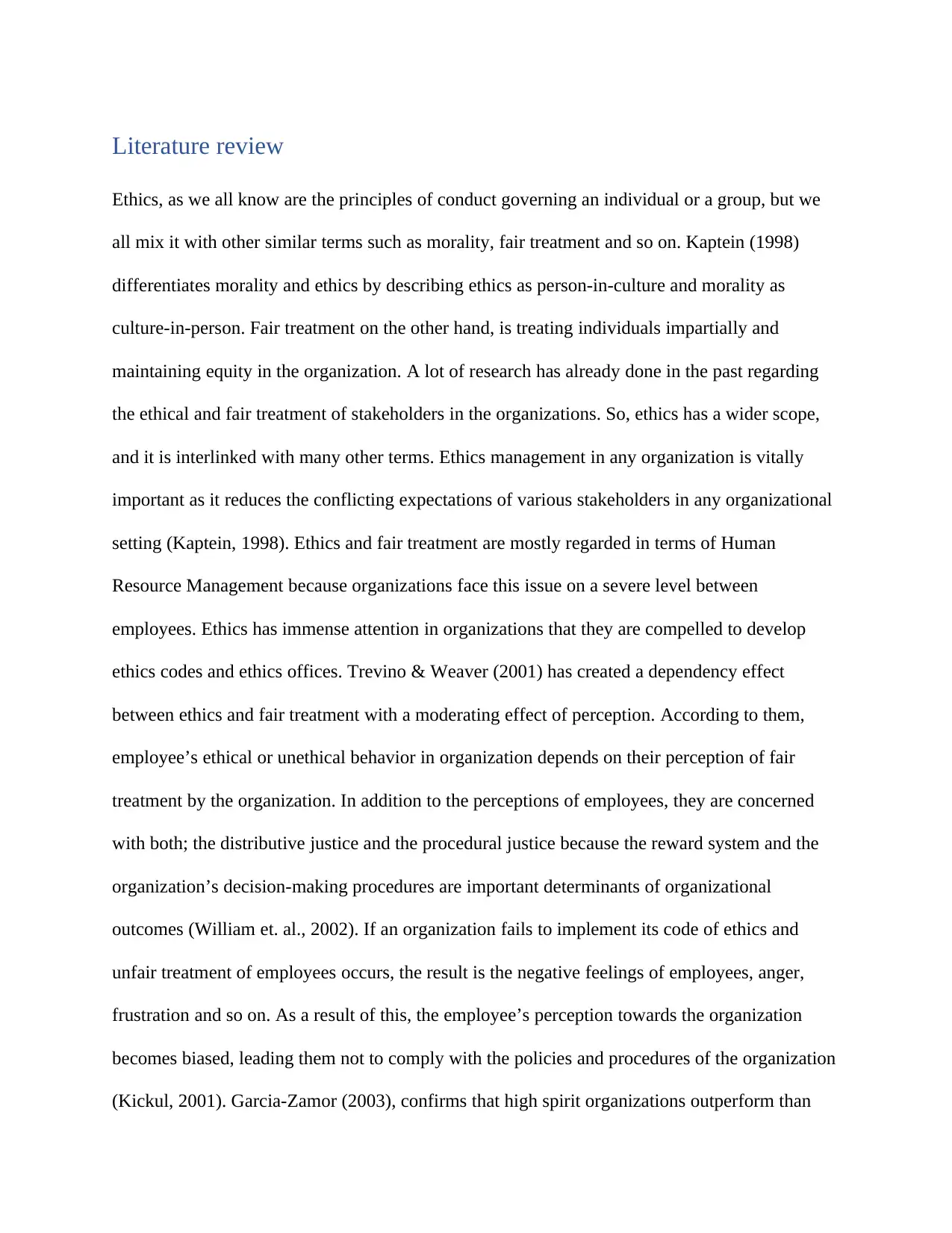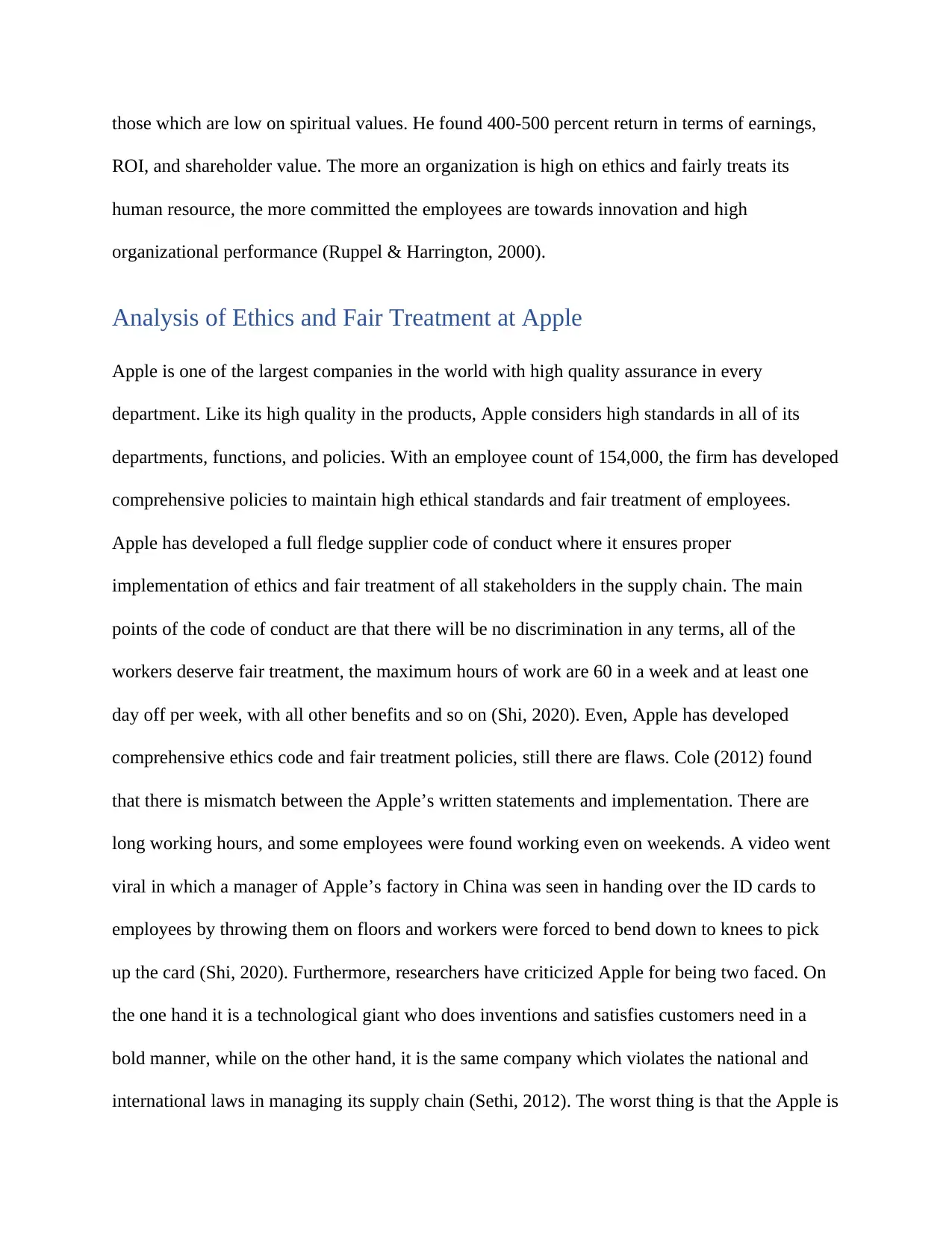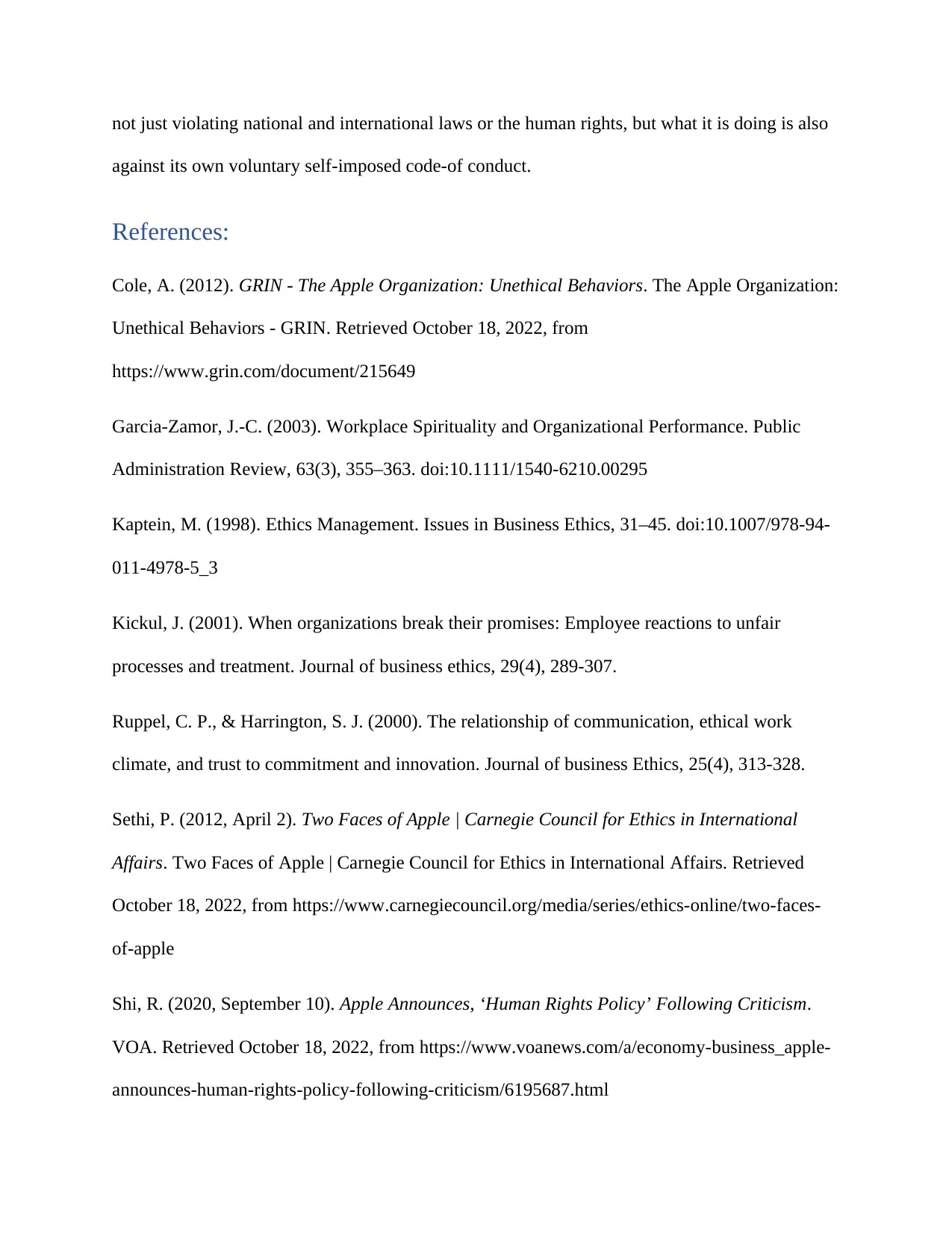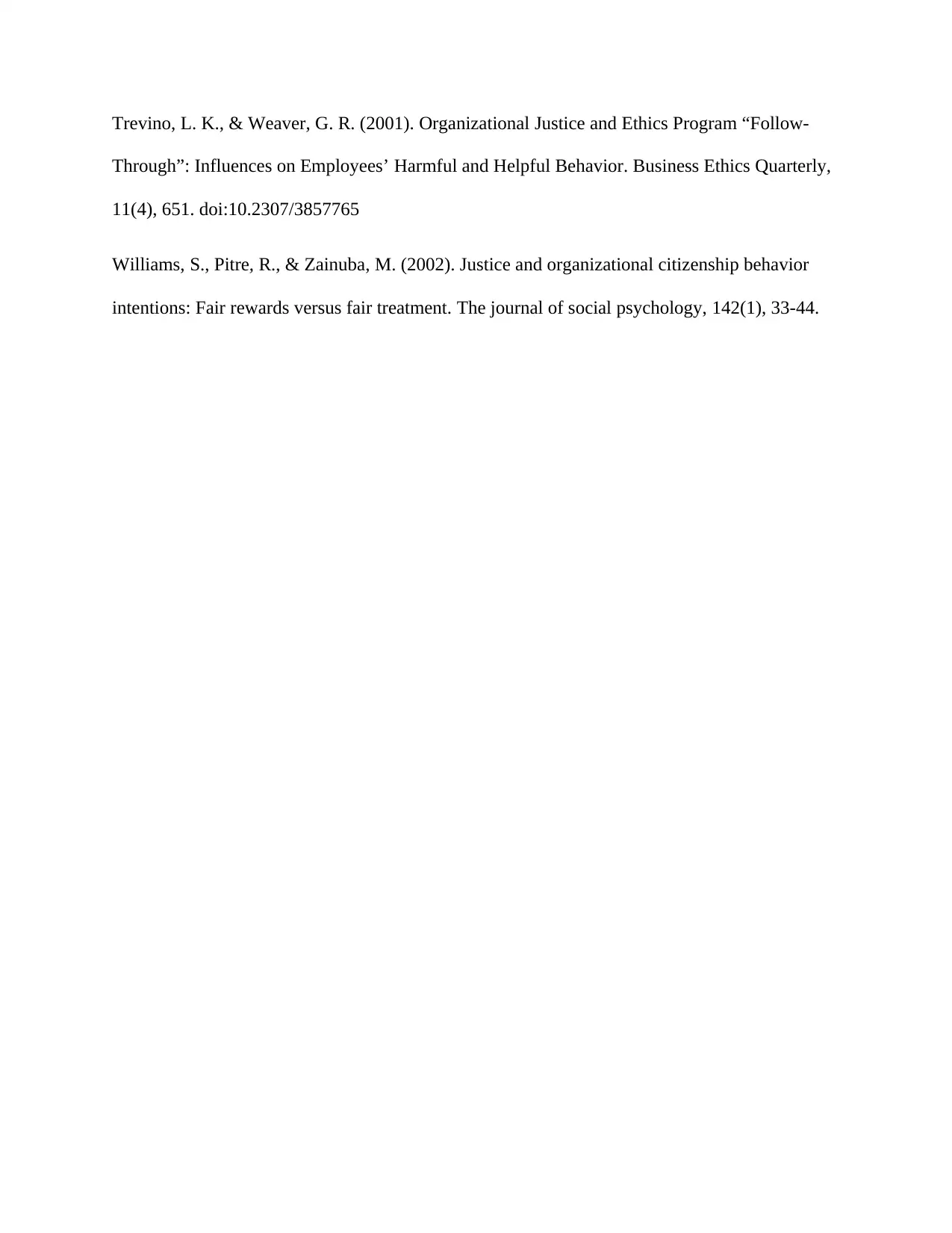Business Ethics: A Literature Review on Ethics and Fair Treatment
VerifiedAdded on 2023/01/23
|4
|1099
|80
Literature Review
AI Summary
This literature review explores the critical importance of ethics and fair treatment within organizations. It differentiates between ethics and morality, emphasizing the significance of ethical management in mitigating stakeholder conflicts. The review highlights the impact of fair treatment on employee perceptions, compliance with organizational policies, and overall performance. A case study on Apple reveals a disparity between the company's stated ethical codes and its actual practices, including issues with working hours and treatment of employees in its supply chain. The review references several key studies and authors, including Kaptein, Trevino & Weaver, and Shi, to support its arguments. The review concludes by emphasizing the link between ethical practices, employee commitment, and organizational success.

Literature review
Ethics, as we all know are the principles of conduct governing an individual or a group, but we
all mix it with other similar terms such as morality, fair treatment and so on. Kaptein (1998)
differentiates morality and ethics by describing ethics as person-in-culture and morality as
culture-in-person. Fair treatment on the other hand, is treating individuals impartially and
maintaining equity in the organization. A lot of research has already done in the past regarding
the ethical and fair treatment of stakeholders in the organizations. So, ethics has a wider scope,
and it is interlinked with many other terms. Ethics management in any organization is vitally
important as it reduces the conflicting expectations of various stakeholders in any organizational
setting (Kaptein, 1998). Ethics and fair treatment are mostly regarded in terms of Human
Resource Management because organizations face this issue on a severe level between
employees. Ethics has immense attention in organizations that they are compelled to develop
ethics codes and ethics offices. Trevino & Weaver (2001) has created a dependency effect
between ethics and fair treatment with a moderating effect of perception. According to them,
employee’s ethical or unethical behavior in organization depends on their perception of fair
treatment by the organization. In addition to the perceptions of employees, they are concerned
with both; the distributive justice and the procedural justice because the reward system and the
organization’s decision-making procedures are important determinants of organizational
outcomes (William et. al., 2002). If an organization fails to implement its code of ethics and
unfair treatment of employees occurs, the result is the negative feelings of employees, anger,
frustration and so on. As a result of this, the employee’s perception towards the organization
becomes biased, leading them not to comply with the policies and procedures of the organization
(Kickul, 2001). Garcia-Zamor (2003), confirms that high spirit organizations outperform than
Ethics, as we all know are the principles of conduct governing an individual or a group, but we
all mix it with other similar terms such as morality, fair treatment and so on. Kaptein (1998)
differentiates morality and ethics by describing ethics as person-in-culture and morality as
culture-in-person. Fair treatment on the other hand, is treating individuals impartially and
maintaining equity in the organization. A lot of research has already done in the past regarding
the ethical and fair treatment of stakeholders in the organizations. So, ethics has a wider scope,
and it is interlinked with many other terms. Ethics management in any organization is vitally
important as it reduces the conflicting expectations of various stakeholders in any organizational
setting (Kaptein, 1998). Ethics and fair treatment are mostly regarded in terms of Human
Resource Management because organizations face this issue on a severe level between
employees. Ethics has immense attention in organizations that they are compelled to develop
ethics codes and ethics offices. Trevino & Weaver (2001) has created a dependency effect
between ethics and fair treatment with a moderating effect of perception. According to them,
employee’s ethical or unethical behavior in organization depends on their perception of fair
treatment by the organization. In addition to the perceptions of employees, they are concerned
with both; the distributive justice and the procedural justice because the reward system and the
organization’s decision-making procedures are important determinants of organizational
outcomes (William et. al., 2002). If an organization fails to implement its code of ethics and
unfair treatment of employees occurs, the result is the negative feelings of employees, anger,
frustration and so on. As a result of this, the employee’s perception towards the organization
becomes biased, leading them not to comply with the policies and procedures of the organization
(Kickul, 2001). Garcia-Zamor (2003), confirms that high spirit organizations outperform than
Paraphrase This Document
Need a fresh take? Get an instant paraphrase of this document with our AI Paraphraser

those which are low on spiritual values. He found 400-500 percent return in terms of earnings,
ROI, and shareholder value. The more an organization is high on ethics and fairly treats its
human resource, the more committed the employees are towards innovation and high
organizational performance (Ruppel & Harrington, 2000).
Analysis of Ethics and Fair Treatment at Apple
Apple is one of the largest companies in the world with high quality assurance in every
department. Like its high quality in the products, Apple considers high standards in all of its
departments, functions, and policies. With an employee count of 154,000, the firm has developed
comprehensive policies to maintain high ethical standards and fair treatment of employees.
Apple has developed a full fledge supplier code of conduct where it ensures proper
implementation of ethics and fair treatment of all stakeholders in the supply chain. The main
points of the code of conduct are that there will be no discrimination in any terms, all of the
workers deserve fair treatment, the maximum hours of work are 60 in a week and at least one
day off per week, with all other benefits and so on (Shi, 2020). Even, Apple has developed
comprehensive ethics code and fair treatment policies, still there are flaws. Cole (2012) found
that there is mismatch between the Apple’s written statements and implementation. There are
long working hours, and some employees were found working even on weekends. A video went
viral in which a manager of Apple’s factory in China was seen in handing over the ID cards to
employees by throwing them on floors and workers were forced to bend down to knees to pick
up the card (Shi, 2020). Furthermore, researchers have criticized Apple for being two faced. On
the one hand it is a technological giant who does inventions and satisfies customers need in a
bold manner, while on the other hand, it is the same company which violates the national and
international laws in managing its supply chain (Sethi, 2012). The worst thing is that the Apple is
ROI, and shareholder value. The more an organization is high on ethics and fairly treats its
human resource, the more committed the employees are towards innovation and high
organizational performance (Ruppel & Harrington, 2000).
Analysis of Ethics and Fair Treatment at Apple
Apple is one of the largest companies in the world with high quality assurance in every
department. Like its high quality in the products, Apple considers high standards in all of its
departments, functions, and policies. With an employee count of 154,000, the firm has developed
comprehensive policies to maintain high ethical standards and fair treatment of employees.
Apple has developed a full fledge supplier code of conduct where it ensures proper
implementation of ethics and fair treatment of all stakeholders in the supply chain. The main
points of the code of conduct are that there will be no discrimination in any terms, all of the
workers deserve fair treatment, the maximum hours of work are 60 in a week and at least one
day off per week, with all other benefits and so on (Shi, 2020). Even, Apple has developed
comprehensive ethics code and fair treatment policies, still there are flaws. Cole (2012) found
that there is mismatch between the Apple’s written statements and implementation. There are
long working hours, and some employees were found working even on weekends. A video went
viral in which a manager of Apple’s factory in China was seen in handing over the ID cards to
employees by throwing them on floors and workers were forced to bend down to knees to pick
up the card (Shi, 2020). Furthermore, researchers have criticized Apple for being two faced. On
the one hand it is a technological giant who does inventions and satisfies customers need in a
bold manner, while on the other hand, it is the same company which violates the national and
international laws in managing its supply chain (Sethi, 2012). The worst thing is that the Apple is

not just violating national and international laws or the human rights, but what it is doing is also
against its own voluntary self-imposed code-of conduct.
References:
Cole, A. (2012). GRIN - The Apple Organization: Unethical Behaviors. The Apple Organization:
Unethical Behaviors - GRIN. Retrieved October 18, 2022, from
https://www.grin.com/document/215649
Garcia-Zamor, J.-C. (2003). Workplace Spirituality and Organizational Performance. Public
Administration Review, 63(3), 355–363. doi:10.1111/1540-6210.00295
Kaptein, M. (1998). Ethics Management. Issues in Business Ethics, 31–45. doi:10.1007/978-94-
011-4978-5_3
Kickul, J. (2001). When organizations break their promises: Employee reactions to unfair
processes and treatment. Journal of business ethics, 29(4), 289-307.
Ruppel, C. P., & Harrington, S. J. (2000). The relationship of communication, ethical work
climate, and trust to commitment and innovation. Journal of business Ethics, 25(4), 313-328.
Sethi, P. (2012, April 2). Two Faces of Apple | Carnegie Council for Ethics in International
Affairs. Two Faces of Apple | Carnegie Council for Ethics in International Affairs. Retrieved
October 18, 2022, from https://www.carnegiecouncil.org/media/series/ethics-online/two-faces-
of-apple
Shi, R. (2020, September 10). Apple Announces, ‘Human Rights Policy’ Following Criticism.
VOA. Retrieved October 18, 2022, from https://www.voanews.com/a/economy-business_apple-
announces-human-rights-policy-following-criticism/6195687.html
against its own voluntary self-imposed code-of conduct.
References:
Cole, A. (2012). GRIN - The Apple Organization: Unethical Behaviors. The Apple Organization:
Unethical Behaviors - GRIN. Retrieved October 18, 2022, from
https://www.grin.com/document/215649
Garcia-Zamor, J.-C. (2003). Workplace Spirituality and Organizational Performance. Public
Administration Review, 63(3), 355–363. doi:10.1111/1540-6210.00295
Kaptein, M. (1998). Ethics Management. Issues in Business Ethics, 31–45. doi:10.1007/978-94-
011-4978-5_3
Kickul, J. (2001). When organizations break their promises: Employee reactions to unfair
processes and treatment. Journal of business ethics, 29(4), 289-307.
Ruppel, C. P., & Harrington, S. J. (2000). The relationship of communication, ethical work
climate, and trust to commitment and innovation. Journal of business Ethics, 25(4), 313-328.
Sethi, P. (2012, April 2). Two Faces of Apple | Carnegie Council for Ethics in International
Affairs. Two Faces of Apple | Carnegie Council for Ethics in International Affairs. Retrieved
October 18, 2022, from https://www.carnegiecouncil.org/media/series/ethics-online/two-faces-
of-apple
Shi, R. (2020, September 10). Apple Announces, ‘Human Rights Policy’ Following Criticism.
VOA. Retrieved October 18, 2022, from https://www.voanews.com/a/economy-business_apple-
announces-human-rights-policy-following-criticism/6195687.html
⊘ This is a preview!⊘
Do you want full access?
Subscribe today to unlock all pages.

Trusted by 1+ million students worldwide

Trevino, L. K., & Weaver, G. R. (2001). Organizational Justice and Ethics Program “Follow-
Through”: Influences on Employees’ Harmful and Helpful Behavior. Business Ethics Quarterly,
11(4), 651. doi:10.2307/3857765
Williams, S., Pitre, R., & Zainuba, M. (2002). Justice and organizational citizenship behavior
intentions: Fair rewards versus fair treatment. The journal of social psychology, 142(1), 33-44.
Through”: Influences on Employees’ Harmful and Helpful Behavior. Business Ethics Quarterly,
11(4), 651. doi:10.2307/3857765
Williams, S., Pitre, R., & Zainuba, M. (2002). Justice and organizational citizenship behavior
intentions: Fair rewards versus fair treatment. The journal of social psychology, 142(1), 33-44.
1 out of 4
Related Documents
Your All-in-One AI-Powered Toolkit for Academic Success.
+13062052269
info@desklib.com
Available 24*7 on WhatsApp / Email
![[object Object]](/_next/static/media/star-bottom.7253800d.svg)
Unlock your academic potential
Copyright © 2020–2025 A2Z Services. All Rights Reserved. Developed and managed by ZUCOL.





